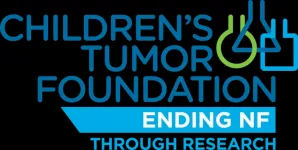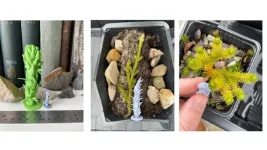(Press-News.org)
‘Weed early and often’ is the key to a productive garden. Interestingly, certain species of ants are also avid gardeners, a practice they’ve refined over 50 million years. They too weed their underground fungus gardens, but how they know what to weed out has been a mystery. Now, a multidisciplinary team of scientists report in PNAS on June 15 how ants distinguish the good fungus from the bad.
People rely on sight to identify weeds but ants grow fungus underground in the dark and must have other ways to sense undesirable garden denizens. A team led by Jonathan Klassen, Ph.D., at the University of Connecticut and Marcy Balunas, Ph.D., at the University of Michigan has found that the ants sniff out diseased fungus by detecting chemicals called peptaibols.
The team focused on the ant species Trachymyrmex septentrionalis whose habitat follows the pine barren ecosystem from Long Island all the way south to East Texas. Trachymyrmex ants grow their fungus below ground and feed it fresh organic detritus. The fungus acts almost like an external gut for the ant colony; the fungus grows up and around the fresh food laid on top of it in honeycomb shapes, produces digested food for the ants as it grows, and then secretes waste.
Klassen Lab graduate student Katie Kyle, a co-first author on the paper, experimentally infected ant nests with Trichoderma, a naturally occurring, disease-causing fungus that infects the ants’ gardens and found that the ants began working overtime to remove the infection from the nests, increasing their waste output.
Over the winter, while the ants were dormant, the team analyzed the fungal biomes of several different ant nests collected from different locations and found Trichoderma in all of them.
Co-first author Sara Puckett, Ph.D., a recent graduate from the Balunas’ UConn lab, prepared extracts of Trichoderma containing the organic compounds of the fungus to determine if the weeding was triggered by one or more of these compounds or simply by the presence of the pathogen’s cells.
“We were curious to see if the ants were weeding because of compounds produced by the infecting fungus,” Balunas said.
The team found the Trichoderma extract, when applied to the fungus garden, sent the ants into frenzied weeding activity just as actual Trichoderma infections had.
Working with scientists from University of California, San Diego and University of North Carolina, Greensboro, they discovered the nests contained peptaibols, a family of compounds known to be produced by Trichoderma. However, finding which specific peptaibols were causing ant weeding proved more challenging since these extracts contained many compounds.
The researchers tested pure peptaibols, including two new compounds called trichokindins VIII and IX.
It turns out that all the peptaibols tested caused some level of ant weeding, a finding that implies it may not be one particular peptaibol but rather that the whole suite of peptaibols can induce the ants to weed their garden.
“This suite of Trichoderma compounds inducing ant behavior is in contrast to many other natural products whose activity can often be attributed to one compound,” Balunas says.
Although their data support peptaibols as a signal to weed, it’s not clear what exactly the ants are perceiving. It may be that the invading Trichoderma fungus produces the peptaibols and the ants detect them and then weed, note the researchers. Or perhaps the ants are detecting a secondary response from the fungus garden itself.
The next step is to figure out those details of ant-fungus communication, Klassen says.
“Maybe the fungus is signaling ‘I’m sick’. Maybe the fungus is detecting the peptaibols. We need to flesh out the chain of signaling,” Klassen says.
The findings highlight one of the few known systems where an animal responds to a disease of its beneficial symbiotic partner instead of a disease of its own body, a phenomenon that Balunas and Klassen are calling an extended defense response, and one that they look forward to continuing to tease apart.
END
Biological treatment processes are critical for sewage purification, wherein microbial interactions are tightly associated with treatment performance. Previous studies have focused on assessing how environmental factors (such as salinity) affect the diversity and composition of the microbial community but ignore the connections among microorganisms. To fill this gap, an international team of researchers conducted an in-depth analysis of microbial interactions at elevated salinity in activated sludge systems.
Biological ...
HOUSTON – (June 16, 2023) – Rice University chemist Anatoly Kolomeisky has won an award from the National Science Foundation to investigate how heterogeneity affects chemical and biological processes. The goal of his project is to develop analytical models that quantify the role of heterogeneity in various phenomena including catalytic reactions, antimicrobial peptides, early cancer development and lysis, a process describing cellular membrane breakdown.
“We live in a world of heterogeneity,” ...
BOSTON – New research from Boston Medical Center found a significant correlation between biomarkers in the vitreous humor of the eye and pathologically confirmed cases of Alzheimer’s disease (AD) and Chronic Traumatic Encephalopathy (CTE) in post-mortem brain and eye tissue. Published in IOS Press, this exploratory study indicates that biomarkers in the vitreous humor may serve as a proxy for neuropathological disease.
The incidence of dementias like AD continues to rise. As of 2021, 6.2 million North Americans above 65 years of age are suffering from AD, and this number is projected to reach 13.2 million by 2060. Diagnosis of both AD and CTE is based on symptoms, clinical exam ...
The Children’s Tumor Foundation (CTF) has announced that Brigid Garelik, MD, MPH, has been appointed Chief Medical Officer, overseeing the Foundation’s research and clinical initiatives. In this role, Dr. Garelik will set direction for the Foundation’s innovative R&D programs, developing effective clinical and preclinical strategies in order to deliver treatments to patients. She will also direct the Foundation’s educational programs in support of NF healthcare professionals, growing the NF field, and R&D related patient engagement. She will report to the President of the Children’s Tumor Foundation, Annette Bakker, PhD.
Dr. Garelik is an accomplished ...
A new SGD 77 million research initiative has been launched today at the National University of Singapore (NUS) to boost innovation and research on advanced solar cell technologies in Singapore. Over the next five years, the REC@NUS Corporate R&D Laboratory for Next Generation Photovoltaics (REC@NUS Corp Lab), which is jointly set up by the Solar Energy Research Institute of Singapore (SERIS) at NUS and REC Solar (REC), will research, develop, and commercialise disruptive solar photovoltaic (PV) technologies based on perovskite-silicon tandem solar cells.
Supported ...
A chemical linked to a higher risk of leukemia and other blood cell cancers creeps into millions of homes whenever residents light their gas stoves. A new Stanford-led analysis finds that a single gas cooktop burner on high or a gas oven set to 350 degrees Fahrenheit can raise indoor levels of the carcinogen benzene above those in secondhand tobacco smoke. Benzene also drifts throughout a home and lingers for hours in home air, according to the paper published June 22 in Environmental Science & ...
Leaf arrangements in the earliest plants differ from most modern plants, overturning a long-held theory regarding the origins of a famous mathematical pattern found in nature, research shows.
The findings indicate that the arrangement of leaves into distinctive spirals, that are common in nature today, were not common in the most ancient land plants that first populated the earth’s surface.
Instead, the ancient plants were found to have another type of spiral. This negates a long held theory about the evolution of plant leaf spirals, indicating that they evolved ...
About The Study: The results of this study suggest that Black veterans have lower rates of lung cancer screening that are not fully explained by demographic and socioeconomic variables, underscoring the need for further qualitative studies on barriers to lung cancer screening as well as evidence-based interventions targeted to Black veterans.
Authors: Neelima Navuluri, M.D., M.P.H., of the Duke University School of Medicine in Durham, North Carolina, is the corresponding author.
To access the embargoed study: ...
About The Study: The findings of this qualitative study suggest that institutional plans to protect frontline clinicians from the responsibility for allocating scarce resources may be unworkable, especially in a state of chronic crisis. Efforts are needed to directly integrate frontline clinicians into institutional emergency responses and support them in ways that reflect the complex and dynamic realities of health care resource limitation.
Authors: Catherine R. Butler, M.D., M.A., of the University of Washington in Seattle, ...
A new study by an international team from Africa, Asia and Europe has put forward three criteria for evaluating the success of migration as adaptation in the face of climate change: well-being, equity and sustainability.
The study shows that while migration is increasingly recognised as an effective way to deal with climate risks, or a form of adaptation, it is far from a silver-bullet solution.
For example, remittances – which include flows of money, ideas, skills and goods between migrants and their places of origin – are thought to be key to facilitating adaptation to climate change.
But, drawing on evidence from every continent ...





